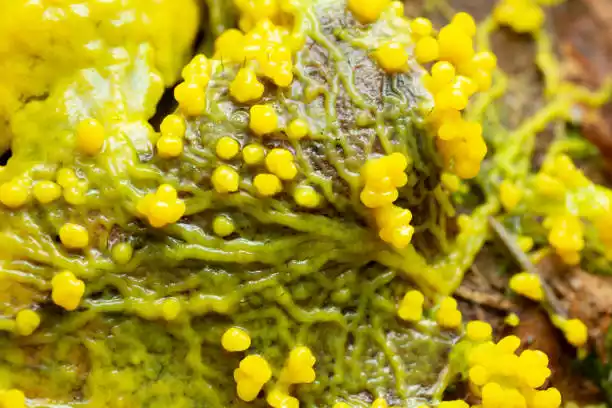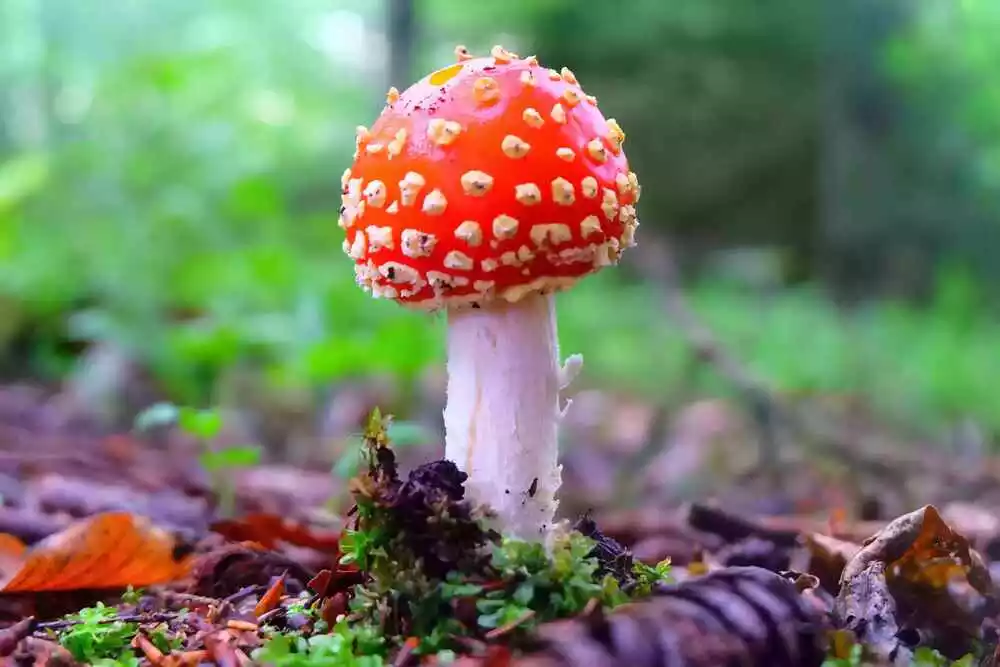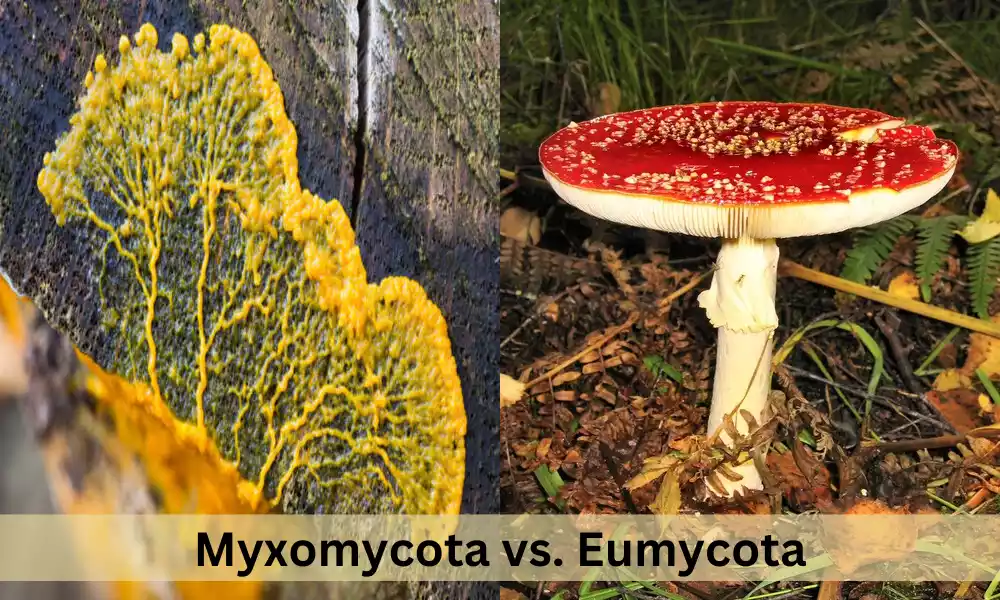Myxomycota, often called slime molds, are unique among fungi due to their amoeboid or plasmodial phase where they exist as multinucleate structures called plasmodia. They feed through phagocytosis, engulfing organic matter.
Myxomycota has a complex life cycle involving amoeboid, flagellated, and plasmodial stages. They form spore-bearing structures called sporangia to reproduce.
On the other hand, Eumycota, known as true fungi, possess a filamentous structure composed of hyphae. These fungi secrete enzymes that break down complex organic compounds outside their bodies into simpler substances, which they then absorb.
Eumycota reproduce through spores and have a distinct life cycle involving haploid and diploid stages, often characterized by the formation of spores through sexual or asexual reproduction.
What is Myxomycota?
Myxomycota, commonly known as slime molds, represent a diverse group of organisms classified within the kingdom Protista or more recently within the broader kingdom of Amoebozoa. Slime molds are unique organisms that exhibit characteristics of both fungi and protozoa but are distinct from both groups. They are often considered transitional forms between unicellular organisms like amoebas and multicellular organisms like fungi.
The life cycle of Myxomycota typically involves two main stages: a motile feeding stage known as a plasmodium and a reproductive stage where spores are formed. The plasmodium is a multinucleate, amoeba-like mass that moves and feeds by engulfing microorganisms, organic matter, and bacteria through phagocytosis.

When conditions become unfavorable, the plasmodium transforms into a fruiting body, which produces and releases spores that can develop into new plasmodia under suitable environmental conditions.
Myxomycota can exhibit various forms and colors, often resembling slimy masses or colorful structures found in habitats such as forest floors, decaying logs, leaf litter, or moist environments. They play ecological roles as decomposers, breaking down organic matter, and contributing to nutrient recycling in ecosystems.
Due to their unique life cycle and characteristics, Myxomycota have intrigued scientists for centuries and continue to be objects of study in fields like ecology, biology, and genetics.
Characteristics and Classification
Myxomycota Characteristics and Classification:
Characteristics
-
- Myxomycota feed on organic matter and microorganisms in their environment.
- The vegetative stage is a moving, multinucleate plasmodium.
- Although it looks continuous, the plasmodium comprises individual cells without distinct cell walls.
- Myxomycota exhibit amoeboid movement using pseudopodia.
- The plasmodium transforms into a sporangium during reproduction.
- Environmental conditions influence their life cycle and behavior.
Classification
Kingdom: Protista
Phylum: Amoeba
Class: Myxomycetes
Orders: Physicals (e.g., Physarum polycephalum), Stemonitales (e.g., Stemonitis fusca), Trichiasis (e.g., Trichia spp.), and others. The classification is continually updated with new discoveries and molecular insights.
Major Groups and Examples
Myxomycota can be grouped into two major categories based on their characteristics:
- Plasmodial Slime Molds (Myxogastria): These molds have a large, multinucleate plasmodium in their vegetative stage and include examples like Physarum polycephalum and Fuligo septica.
- Cellular Slime Molds (Dictyostelia): Cellular slime molds exist as individual amoeboid cells during their vegetative stage and form multicellular structures during reproduction. Examples include Dictyostelium discoideum and Dictyostelium purpureum.
Note that classifications may change as scientific research and discoveries uncover new species and relationships within the Myxomycota group.
What Are Eumycota (True Fungi)?
Eumycota also referred to as true fungi or Eumycetes, constitute a diverse group of organisms within the kingdom of Fungi. These organisms encompass a wide range of fungal species that display significant diversity in terms of morphology, ecology, and reproductive strategies.
Characteristically, Eumycota exhibit filamentous structures composed of microscopic threads called hyphae, which collectively form a network known as mycelium. They can be classified into various groups based on their reproductive structures, including ascomycetes (sac fungi), basidiomycetes (club fungi), zygomycetes, and others.
Eumycota play crucial roles in ecosystems as decomposers, symbionts (like mycorrhizal fungi that form associations with plant roots), pathogens causing diseases in plants, animals, and humans, as well as in various industrial applications such as food production, medicine, and biotechnology.

Their life cycle typically involves the production of spores through sexual or asexual reproduction. Sexual reproduction often involves the fusion of specialized reproductive structures (gametes) leading to the formation of spores, whereas asexual reproduction can involve processes like budding, fragmentation, or the production of spores without the involvement of specialized reproductive structures.
Eumycota encompasses an immense diversity of forms, ranging from microscopic unicellular yeasts to large, complex multicellular mushrooms and molds. They are found in various habitats worldwide, including soil, water, air, and living organisms, adapting to diverse environmental conditions.
The study of Eumycota is essential in various scientific fields, including mycology, ecology, medicine, agriculture, and biotechnology, due to their significant ecological roles, economic importance, and potential applications in various industries.
Major Groups and Examples
The main eumycota groups and some examples are:
Myxomycota (Slime Molds)
Plasmodial Slime Molds:
-
- Example: Physarum polycephalum (often found in decaying organic matter)
Cellular Slime Molds:
-
- Example: Dictyostelium discoideum (known for their social behavior during aggregation)
Eumycota (True Fungi)
Ascomycota (Sac Fungi):
-
- Example: Saccharomyces cerevisiae (used in baking and brewing)
- Example: Penicillium chrysogenum (source of penicillin)
Basidiomycota (Club Fungi):
-
- Example: Agaricus bisporus (common mushroom used in cooking)
- Example: Cryptococcus neoformans (pathogenic yeast causing cryptococcosis)
Zygomycota:
-
- Example: Rhizopus stolonifer (bread mold)
Chytridiomycota:
-
- Example: Batrachochytrium dendrobatidis (causes chytridiomycosis in amphibians)
Glomeromycota:
-
- Example: Glomus spp. (important mycorrhizal fungi)
Deuteromycota (or Fungi Imperfecti):
-
- Example: Aspergillus fumigatus (causes aspergillosis in humans)
Why It’s Important to Study Myxomycota and Eumycota Differences
Studying the differences between Myxomycota (slime molds) and Eumycota (true fungi) is crucial for several reasons. Firstly, understanding their distinctions helps in taxonomy and classification, enabling scientists to accurately categorize and comprehend the evolutionary relationships between these organisms.
Secondly, it aids in ecological understanding by highlighting their roles in ecosystems—Myxomycota in nutrient cycling and decomposition, and Eumycota in symbiosis, decomposition, or pathogenesis.
Furthermore, exploring these differences contributes to scientific research, offering potential insights into their unique life cycles, cellular structures, and reproductive strategies, paving the way for innovation in biotechnology, medicine, and environmental studies.
Lastly, their differences underscore the diverse biological strategies that evolved in different branches of life, enhancing our comprehension of biodiversity and evolutionary biology.
What is the major difference between Myxomycota and Eumycota in their mode of nutrition?
The major difference between Myxomycota and Eumycota in their mode of nutrition lies in their feeding strategies. Myxomycota, often referred to as plasmodial or slime molds, exhibit a unique mode of nutrition.
During their vegetative phase, they exist as multinucleate amoeboid structures called plasmodia, which engulf organic matter and feed through phagocytosis. In contrast, Eumycota, also known as true fungi, possess a filamentous structure composed of hyphae.
They secrete enzymes that break down complex organic compounds outside their bodies into simpler substances, which are then absorbed through their cell walls, allowing them to acquire nutrients through external digestion.
This fundamental difference in feeding mechanisms distinguishes Myxomycota’s phagocytic feeding from Eumycota’s absorptive nutrition via external digestion.
Comparison chart of Myxomycota and Eumycota
Below is a comparison chart highlighting the key differences between Myxomycota and Eumycota:
| Characteristics | Myxomycota | Eumycota (True Fungi) |
|---|---|---|
| Cellular Structure | Typically multinucleate, plasmodial stage, lack true multicellular structure | Consist of true multicellular structure with distinct cell walls |
| Reproduction | Plasmodium forms spore-bearing structures (sporangia), undergoes spore release | Forms various reproductive structures like spores, conidia, or fruiting bodies |
| Life Cycle | Alternates between amoeboid, flagellated, and plasmodial stages | Includes haploid and diploid stages (haploid hyphae form spores through sexual or asexual reproduction) |
| Habitat | Found in diverse habitats, including soil, decaying matter, and logs | Occupy a wide range of environments: soil, plants, animals, aquatic habitats, etc. |
| Ecological Role | Contribute to decomposition and nutrient cycling | Functions include decomposition, symbiosis (e.g., mycorrhizae), and pathogens |
| Examples | Physarum polycephalum, Fuligo septica | Aspergillus, Penicillium, Agaricus |
| Cellular Organization | Coenocytic (lacking septa), multinucleate structure | Septate (divided by septa), with individual cells containing one or few nuclei |
| Economic Importance | Limited industrial applications, studied for biological diversity | Vital role in industry (antibiotics, food production, bioremediation), medically significant (some are pathogens) |
| Research Focus | Primarily studied for understanding biodiversity and evolutionary biology | Extensively researched for medical, industrial, and agricultural applications |
Similarities – Myxomycota and Eumycota
Here are the similarities between Myxomycota and Eumycota:
- Both Myxomycota and Eumycota belong to the kingdom of Fungi.
- Both groups reproduce using spores as a means of dispersal.
- They play vital roles in ecosystem functions such as decomposition and nutrient cycling.
- Both can be found in various environments, including soil, decaying matter, and diverse ecosystems.
- Both groups contribute to scientific studies concerning biodiversity, evolutionary biology, and their impact on ecosystems.
Which is called true fungi?
Eumycota is commonly referred to as “true fungi.” This designation stems from their distinct cellular structure, consisting of true multicellular filaments called hyphae, which form the basis of their body structure known as mycelium.
Eumycota exhibits a diverse range of species that encompass molds, yeasts, and mushrooms, among others.
Unlike other fungus-like organisms such as slime molds (Myxomycota) or water molds (Oomycota), Eumycota demonstrates a consistent fungal structure, reproduction through spores, and a well-defined life cycle, making them representative of the traditional characteristics associated with the fungal kingdom.
This classification as “true fungi” emphasizes their morphological and reproductive consistency, setting them apart within the fungal realm.
What is the most primitive Eumycota?
The earliest Eumycota is often regarded as one of the first diverging lineages in the group that is Chytridiomycota, which is the phylum.
Chytrids are distinguished by their distinct characteristic in fungi that they have flagellated spores known as zoospores which is a characteristic that resembles the ancestral aquatic fungi.
This phylum encompasses parasitic and saprophytic species that are which are found in different environments like soil, freshwater, and animal digestive tracts. The very simple structure of Chytridiomycota’s flagellated spores, as well as their evolutionary position, are a key category in understanding the evolutionary beginnings of fungi.
They are regarded as primitive due to their re-incorporation of certain ancestral traits providing insight into the evolution of the various forms that are seen in fungi of today.
Conclusion
Myxomycota and Eumycota are different types of fungi. Myxomycota are single-celled and move like amoebas, while Eumycota are multicellular with specific cell walls. Although they have some similarities, knowing their unique features is crucial for scientists and anyone curious about fungi.




